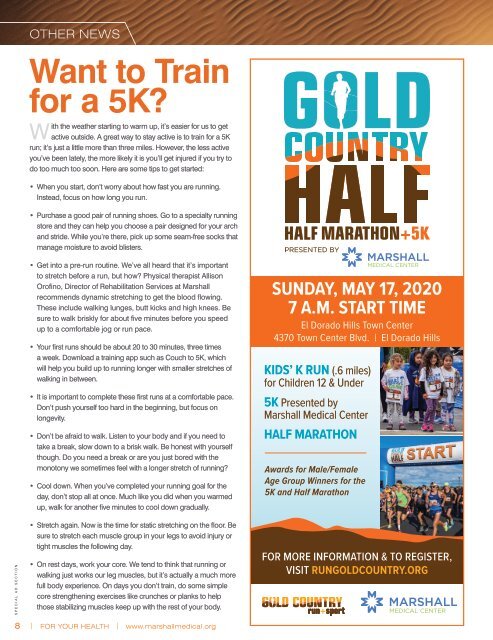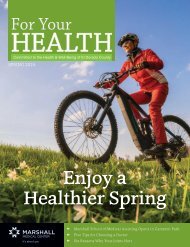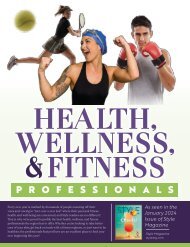Marshall: For Your Health_March 2020
For Your Health is intended to provide information about health in general as well as healthcare services and resources available in El Dorado County. Information comes from a wide range of medical experts. If you have any concerns or questions about specific content that may affect your health, please contact your healthcare provider.
For Your Health is intended to provide information about health in general as well as healthcare services and resources available in El Dorado County. Information comes from a wide range of medical experts. If you have any concerns or questions about specific content that may affect your health, please contact your healthcare provider.
- No tags were found...
You also want an ePaper? Increase the reach of your titles
YUMPU automatically turns print PDFs into web optimized ePapers that Google loves.
OTHER NEWS<br />
Want to Train<br />
for a 5K?<br />
With the weather starting to warm up, it’s easier for us to get<br />
active outside. A great way to stay active is to train for a 5K<br />
run; it’s just a little more than three miles. However, the less active<br />
you’ve been lately, the more likely it is you’ll get injured if you try to<br />
do too much too soon. Here are some tips to get started:<br />
• When you start, don’t worry about how fast you are running.<br />
Instead, focus on how long you run.<br />
• Purchase a good pair of running shoes. Go to a specialty running<br />
store and they can help you choose a pair designed for your arch<br />
and stride. While you’re there, pick up some seam-free socks that<br />
manage moisture to avoid blisters.<br />
• Get into a pre-run routine. We’ve all heard that it’s important<br />
to stretch before a run, but how? Physical therapist Allison<br />
Orofino, Director of Rehabilitation Services at <strong>Marshall</strong><br />
recommends dynamic stretching to get the blood flowing.<br />
These include walking lunges, butt kicks and high knees. Be<br />
sure to walk briskly for about five minutes before you speed<br />
up to a comfortable jog or run pace.<br />
• <strong>Your</strong> first runs should be about 20 to 30 minutes, three times<br />
a week. Download a training app such as Couch to 5K, which<br />
will help you build up to running longer with smaller stretches of<br />
walking in between.<br />
• It is important to complete these first runs at a comfortable pace.<br />
Don’t push yourself too hard in the beginning, but focus on<br />
longevity.<br />
• Don’t be afraid to walk. Listen to your body and if you need to<br />
take a break, slow down to a brisk walk. Be honest with yourself<br />
though. Do you need a break or are you just bored with the<br />
monotony we sometimes feel with a longer stretch of running?<br />
• Cool down. When you’ve completed your running goal for the<br />
day, don’t stop all at once. Much like you did when you warmed<br />
up, walk for another five minutes to cool down gradually.<br />
• Stretch again. Now is the time for static stretching on the floor. Be<br />
sure to stretch each muscle group in your legs to avoid injury or<br />
tight muscles the following day.<br />
Page 1<br />
SPECIAL AD SECTION<br />
• On rest days, work your core. We tend to think that running or<br />
walking just works our leg muscles, but it’s actually a much more<br />
full body experience. On days you don’t train, do some simple<br />
core strengthening exercises like crunches or planks to help<br />
those stabilizing muscles keep up with the rest of your body.<br />
8 | FOR YOUR HEALTH | www.marshallmedical.org

















